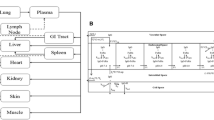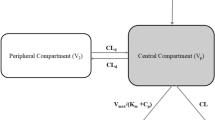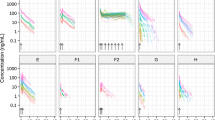Abstract
Background and Objectives
Prediction of human pharmacokinetics for monoclonal antibodies (mAbs) plays an important role for first-in-human (FIH) dose selection. This retrospective analysis compares observed FIH pharmacokinetic data for 16 mAbs to those predicted in humans based on allometric scaling of Cynomolgus monkey pharmacokinetic data.
Methods
Ten mAbs exhibited linear pharmacokinetics in monkeys based on non-compartmental analysis. For these, simple allometric scaling based on bodyweight was applied to predict human clearance (CL) and volume of distribution (Vd) from those obtained in monkeys. Six mAbs exhibited nonlinear pharmacokinetics in monkeys based on population modelling. For these, a population modelling approach using nonlinear mixed-effects modelling software, NONMEM®, was applied to describe monkey data by a two-compartment pharmacokinetic model with parallel linear and nonlinear elimination from the central compartment. The pharmacokinetic parameters in monkeys were then scaled to humans based on simple allometry. Human concentrationtime profiles of these mAbs were then simulated and compared with those observed in the FIH studies.
Results
Antibodies with linear elimination in monkeys also exhibited linear elimination in humans. For these, observed CL and Vd were predicted within 2.3-fold by allometry. The predictability of human peak serum concentration (Cmax) and area under the serum concentration-time curve (AUC) for mAbs with nonlinear pharmacokinetics in monkeys was, however, concentration dependent. Cmax was consistently overestimated (up to 5.3-fold higher) when below the predicted Michaelis-Menten constant (Km; range 0.3–4 μg/mL). The prediction of human Cmax was within 2.3-fold when concentrations greatly exceeded Km. Similarly, differences between predicted human AUCs and those observed in the FIH studies were much greater at low doses/concentrations. Consequently, predicted drug exposure in humans at low starting doses (range 0.01–0.3 mg/kg) in FIH studies was poorly estimated for three of six mAbs with nonlinear pharmacokinetics.
Conclusions
Allometric prediction of human pharmacokinetics may be sufficient for mAbs that exhibit linear pharmacokinetics. For mAbs that exhibited nonlinear pharmacokinetics, the best predictive performance was obtained after doses that achieved target-saturating concentrations.







Similar content being viewed by others
References
Meibohm The role of pharmacokinetics and pharmacodynamics in the development of biotech drugs. In: Meibohm B, editor. Pharmacokinetics and pharmacodynamics of biotech drugs: principles and case studies in drug development. Weinheim: Wiley-VCH, 2006: 3–12
Mascelli MA, Zhou H, Sweet R, et al. Molecular, biologic, and pharmacokinetic properties of monoclonal antibodies: impact of these parameters on early clinical development. J Clin Pharmacol 2007 May; 47(5): 553–65
Wang W, Wang EQ, Balthasar JP. Monoclonal antibody pharmacokinetics and pharmacodynamics. Clin Pharmacol Ther 2008 Nov; 84(5): 548–58
Suntharalingam G, Perry MR, Ward S, et al. Cytokine storm in a phase 1 trial of the anti-CD28 monoclonal antibody TGN1412. N Engl J Med 2006 Sep 7; 355(10): 1018–28
Center for Drug Evaluation and Research, US FDA. Guidance for industry: estimating the maximum safe starting dose in initial clinical trials for therapeutics in adult healthy volunteers. Rockville (MD): FDA, 2005 Jul [online]. Available from URL: http://www.fda.gov/downloads/Drugs/GuidanceComplianceRegulatoryInformation/Guidances/ucm078932.pdf [Accessed 2010 Nov 9]
Committee for Medicinal Products for Human Use, European Medicines Agency. Guideline on strategies to identify and mitigate risks for first-inhuman clinical trials with investigational medicinal products. London: European Medicines Agency, 2007 Jul 19 [online]. Available from URL: http://www.ema.europa.eu/docs/en_GB/document_library/Scientific_guideline/2009/09/WC500002988.pdf [Accessed 2010 Nov 9]
Agoram BM, Martin SW, van der Graaf PH. The role of mechanism-based pharmacokinetic-pharmacodynamic (PK-PD) modelling in translational research of biologics. Drug Discov Today 2007 Dec; 12(23–24): 1018–24
Agoram BM. Use of pharmacokinetic/pharmacodynamic modelling for starting dose selection in first-in-human trials of high-risk biologics. Br J Clin Pharmacol 2009 Feb; 67(2): 153–60
Tabrizi MA, Roskos LK. Preclinical and clinical safety of monoclonal antibodies. Drug Discov Today 2007 Jul; 12(13–14): 540–7
Muller PY, Brennan FR. Safety assessment and dose selection for first-in-human clinical trials with immunomodulatory monoclonal antibodies. Clin Pharmacol Ther 2009 Mar; 85(3): 247–58
Lobo ED, Hansen RJ, Balthasar JP. Antibody pharmacokinetics and pharmacodynamics. J Pharm Sci 2004 Nov; 93(11): 2645–68
Mould DR, Sweeney KR. The pharmacokinetics and pharmacodynamics of monoclonal antibodies: mechanistic modeling applied to drug development. Curr Opin Drug Discov Devel 2007 Jan; 10(1): 84–96
Brambell F. The transimission of immunity from mother to young and the catabolism of immunoglobulins. Lancet 1966; 2(7473): 1087–93
Ling J, Zhou H, Jiao Q, et al. Interspecies scaling of therapeutic monoclonal antibobies: initial look. J Clin Pharmacol 2009 Dec; 49(12): 1382–402
Pendley C, Schantz A, Wagner C. Immunogenicity of therapeutic monoclonal antibodies. Curr Opin Mol Ther 2003 Apr; 5(2): 172–9
Ponce R, Abad L, Amaravadi L, et al. Immunogenicity of biologically-derived therapeutics: assessment and interpretation of nonclinical safety studies. Regul Toxicol Pharmacol 2009 Jul; 54(2): 164–82
Boxenbaum H. Interspecies scaling, allometry, physiological time, and the ground plan of pharmacokinetics. J Pharmacokinet Biopharm 1982 Apr; 10(2): 201–27
Boxenbaum H. Interspecies pharmacokinetic scaling and the evolutionary-comparative paradigm. Drug Metab Rev 1984; 15(5–6): 1071–121
Boxenbaum H, D’Souza RW. Interspecies pharmacokinetic scaling, biological design, and neoteny. In: Testa B, editor. Advances in drug research. London: Academic Press Limited, 1990: 139–96
Chappell WR, Mordenti J. Extrapolation of toxicological and pharmacological data from animals to humans. In: Testa B, editor. Advances in drug research. San Diego (CA): Academic Press, 1991: 1–116
Mordenti J, Chen SA, Moore JA, et al. Interspecies scaling of clearance and volume of distribution data for five therapeutic proteins. Pharm Res 1991 Nov; 8(11): 1351–9
Grene-Lerouge NA, Bazin-Redureau MI, Debray M, et al. Interspecies scaling of clearance and volume of distribution for digoxin-specific Fab. Toxicol Appl Pharmacol 1996 May; 138(1): 84–9
Bazin-Redureau M, Pepin S, Hong G, et al. Interspecies scaling of clearance and volume of distribution for horse antivenom F(ab’)2. Toxicol Appl Pharmacol 1998 Jun; 150(2): 295–300
Mahmood I. Interspecies scaling of protein drugs: prediction of clearance from animals to humans. J Pharm Sci 2004 Jan; 93(1): 177–85
Kelley SK, Gelzleichter T, Xie D, et al. Preclinical pharmacokinetics, pharmacodynamics, and activity of a humanized anti-CD40 antibody (SGN-40) in rodents and non-human primates. Br J Pharmacol 2006 Aug; 148(8): 1116–23
Lin YS, Nguyen C, Mendoza JL, et al. Preclinical pharmacokinetics, interspecies scaling, and tissue distribution of a humanized monoclonal antibody against vascular endothelial growth factor. J Pharmacol Exp Ther 1999 Jan; 288(1): 371–8
Duconge J, Fernandez-Sanchez E, Alvarez D. Interspecies scaling of the monoclonal anti-EGF receptor ior EGFantibody disposition using allometric paradigm: is it really suitable? Biopharm Drug Dispos 2004 May; 25(4): 177–86
Kuester K, Kloft C. Pharmacokinetics of monoclonal antibodies. In: Meibohm B, editor. Pharmacokinetics and pharmacodynamics of biotech drugs: principles and case studies in drug development. Weinheim: Wiley-VCH, 2006: 45–91
Dedrick RL. Animal scale-up. J Pharmacokinet Biopharm 1973 Oct; 1(5): 435–61
Mordenti J. Man versus beast: pharmacokinetic scaling in mammals. J Pharm Sci 1986 Nov; 75(11): 1028–40
US FDA. Drug approval package: Avastin (bevacizumab). Summary basis of approval [online]. Available from URL: http://www.accessdata.fda.gov/drugsatfda_docs/nda/2004/STN-125085_Avastin.cfm [Accessed 2010 Nov 26]
Hakimi J, Chizzonite R, Luke DR, et al. Reduced immunogenicity and improved pharmacokinetics of humanized anti-Tac in cynomolgus monkeys. J Immunol 1991 Aug 15; 147(4): 1352–9
Rojas JR, Taylor RP, Cunningham MR, et al. Formation, distribution, and elimination of infliximab and anti-infliximab immune complexes in cynomolgus monkeys. J Pharmacol Exp Ther 2005 May; 313(2): 578–85
US FDA. Infliximab product approval information — licensing action: Remicade. Summary basis of approval [online]. Available from URL: http://www.fda.gov/Drugs/DevelopmentApprovalProcess/HowDrugsareDevelopedandApproved/ApprovalApplications/TherapeuticBiologicApplications/ucm093327.htm [Accessed 2010 Nov 26]
US FDA. Overview: Rituxan (rituximab). Summary basis of approval [online]. Available from URL: http://www.accessdata.fda.gov/scripts/cder/drugsatfda/index.cfm?fuseaction=Search.Overview&DrugName=RITUXAN&CFID=51165734&CFTOKEN=c8cf74698099620-6129AB8A-B4E8-AA2F-738FF37B5F9776F9 [Accessed 2010 Nov 26]
Ng CM, Bruno R, Combs D, et al. Population pharmacokinetics of rituximab (anti-CD20 monoclonal antibody) in rheumatoid arthritis patients during a phase II clinical trial. J Clin Pharmacol 2005 Jul; 45(7): 792–801
IVIG HCA pharmacy protocol [online]. Available from URL: http://www.docstoc.com/docs/19660410/IVIG-PHARMACY-PROTOCOL [Accessed 2010 Dec 3]
Thurmann PA, Sonnenburg-Chatzopoulos C, Lissner R. Pharmacokinetic characteristics and tolerability of a novel intravenous immunoglobulin preparation. Eur J Clin Pharmacol 1995; 49(3): 237–42
Ito K, Houston JB. Prediction of human drug clearance from in vitro and preclinical data using physiologically based and empirical approaches. Pharm Res 2005 Jan; 22(1): 103–12
Adolph EF. Quantitative relations in the physiological constitutions of mammals. Science 1949 Jun 10; 109(2841): 579–85
US FDA. Trastuzumab product approval information — licensing action 9/25/98: Herceptin. Summary basis of approval [online]. Available from URL: http://www.fda.gov/Drugs/DevelopmentApprovalProcess/HowDrugsare DevelopedandApproved/ApprovalApplications/TherapeuticBiologicAp plications/ucm080591.htm [Accessed 2010 Nov 26]
US FDA. Drug approval package: Mylotarg (gemtuzumab ozogamicin) injection. Summary basis of approval [online]. Available from URL: http://www.accessdata.fda.gov/drugsatfda_docs/nda/2000/21174_Mylotorg.cfm [Accessed 2010 Nov 26]
US FDA. Drug approval package: Vectibix panitumumab injectable. Summary basis of approval [online]. Available from URL: http://www.accessdata.fda.gov/drugsatfda_docs/nda/2006/125147s0000TOC.cfm [Accessed 2010 Nov 26]
Kagan L, Abraham AK, Harrold JM, et al. Interspecies scaling of receptor-mediated pharmacokinetics and pharmacodynamics of type I interferons. Pharm Res 2010 May; 27(5): 920–32
Gibiansky L, Gibiansky E, Kakkar T, et al. Approximations of the targetmediated drug disposition model and identifiability of model parameters. J Pharmacokinet Pharmacodyn 2008 Oct; 35(5): 573–91
Gibiansky L, Gibiansky E. Target-mediated drug disposition model: approximations, identifiability of model parameters and applications to the population pharmacokinetic-pharmacodynamic modeling of biologics. Expert Opin Drug Metab Toxicol 2009 Jul; 5(7): 803–12
Xu Z, Vu T, Lee H, et al. Population pharmacokinetics of golimumab, an antitumor necrosis factor-alpha human monoclonal antibody, in patients with psoriatic arthritis. J Clin Pharmacol 2009 Sep; 49(9): 1056–70
Sun YN, Lu JF, Joshi A, et al. Population pharmacokinetics of efalizumab (humanized monoclonal anti-CD 11a antibody) following long-term subcutaneous weekly dosing in psoriasis subjects. J Clin Pharmacol 2005 Apr; 45(4): 468–76
Zhou H, Hu C, Zhu Y, et al. Population-based exposure-efficacy modeling of ustekinumab in patients with moderate to severe plaque psoriasis. J Clin Pharmacol 2010 Mar; 50(3): 257–67
Mager DE, Jusko WJ. Receptor-mediated pharmacokinetic/pharmacodynamic model of interferon-beta 1a in humans. Pharm Res 2002 Oct; 19(10): 1537–43
Savic RM, Jonker DM, Kerbusch T, et al. Implementation of a transit compartment model for describing drug absorption in pharmacokinetic studies. J Pharmacokinet Pharmacodyn 2007 Oct; 34(5): 711–26
Vugmeyster Y, Tian X, Szklut P, et al. Pharmacokinetic and pharmacodynamic modeling of a humanized anti-IL-13 antibody in naive and Ascaris-challenged cynomolgus monkeys. Pharm Res 2009 Feb; 26(2): 306–15
Lowe PJ. Applying physiological and biochemical concepts to optimize biological drug development. Clin Pharmacol Ther 2010 Apr; 87(4): 492–6
Mager DE, Woo S, Jusko WJ. Scaling pharmacodynamics from in vitro and preclinical animal studies to humans. Drug Metab Pharmacokinet 2009; 24(1): 16–24
Acknowledgements
No source of funding was used to assist in the preparation of this manuscript. The authors wish to thank Dr Marc Gastonguay for insightful technical discussion and Dr Donald Mager for critical review of the manuscript. All authors are employees of Amgen and own Amgen shares. The authors have no other conflicts of interest that are directly relevant to the content of this study.
Author information
Authors and Affiliations
Corresponding author
Electronic supplementary material
Rights and permissions
About this article
Cite this article
Dong, J.Q., Salinger, D.H., Endres, C.J. et al. Quantitative Prediction of Human Pharmacokinetics for Monoclonal Antibodies. Clin Pharmacokinet 50, 131–142 (2011). https://doi.org/10.2165/11537430-000000000-00000
Published:
Issue Date:
DOI: https://doi.org/10.2165/11537430-000000000-00000




